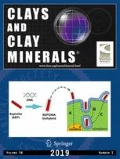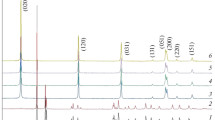Abstract
Thirty two boehmites, synthesized at temperatures ranging from room temperature to 300°C, were examined by scanning electron microscopy, transmission electron microscopy, electron diffraction, X-ray powder diffraction, differential thermal analysis, and infrared spectroscopy. The results show that boehmite exhibits a continuous gradation in crystallite size ranging from single octahedral layers or a few unit cells to about 65 unit cells in the y-direction. This conclusion suggests that the term pseudoboehmite is inappropriate for finely crystalline boehmite. Finely crystalline boehmite contains more sorbed water than coarsely crystalline boehmite; this water is commonly intercalated between octahedral layers, usually randomly but sometimes regularly. The regularly interstratified boehmite gives rise to a diffuse “long spacing” X-ray diffraction reflection. Calculated 020 X-ray diffraction peaks approximate closely those observed experimentally when a range of crystallite sizes is taken into account.
Резюме
Тридцать два бемиты, синтезированные при температурах, изменяющихся от комнатной до 300°С, были исследованы с помощью электронного сканирующего микроскопа, электронного трансмиссионного микроскопа, дифракции электронов, рентгеновского порошкового анализа, дифференциального термического анализа, и инффакрасной спектроскопии. Результаты показывают, что бемит проявляет сплошную градацию размеров кристаллитов, изменяющихся от простых октаедрических слоев или немногих елементарных ячеек вплоть до примерно 65 елементарных ячеек по у-направлению. Этот вывод подсказывает, что термин псевдобемит является несоответствующим для тонко-кристаллического бемита. Тонко-кристаллиуеский бемит содержит большее количество сорбированной води, чем грубо-кристаллический бемит; эта вода обыкновенно находится между октаедрическими слоями, обычно беспорядочно, но иногда регулярно. Регулярно внутринапластованный бемит приводит к рентгеновскому отражению с диффузионным “длинным расстоянием.” Когда берется во внимание диапазон размеров кристаллитов, расчетные 020 рентгеновские пики находятся в хорошем соответствии с экспериментальными величинами. [Е.С.]
Resümee
Zweiunddreißig, im Temperaturbereich von Zimmertemperatur bis 300°C synthetisierte Boehmite wurden mittels Rasterelektronenmikroskopie, Transmissionselektronenmikroskopie, Elektronenbeugung, Röntgenpulverdiffraktometrie, Differentialthermoanalyse, und Infrarotspektroskopie untersucht. Die Ergebnisse zeigen, daß sich die Kristallitengröße des Boehmits allmählich ändert und von einzelnen oktaedrischen Lagen oder einigen Elementarzellen bis zu ~65 Elementarzellen in der y-Richtung reicht. Diese Schlußfolgerung deutet darauf hin, daß der Ausdruck Pseudoboehmit für feinkristallinen Boehmit unangebracht ist. Feinkristallisierter Boehmit enthält mehr adsorbiertes Wasser als grobkristallisierter; dieses Wasser ist gewöhnlich zwischen oktaedrische Lagen eingeschaltet und zwar meist statistisch, jedoch manchmal geordnet. Der regelmäßig wechselgelagerte Boehmit gibt eine diffuse “long spacing” Röntgen-reflexion. Berechnete 020 Peaks liegen nahe bei den experimentell beobachteten, wenn man eine Variation der Kristallitengröße berücksichtigt. [U.W.]
Résumé
Trente deux boehmites, synthétisées à des températures s’étageant de température ambiante à 300°C ont été examinées par microscopie électronique balayante, microscopie électronique par transmission, diffraction électronique, diffraction poudrée aux rayons-X, analyse thermale différentielle, et spectroscopic infrarouge. Les résultats montrent que la boéhmite exhibe une gradation continuelle de la taille cristalline, s’étageant de couches octaèdres simples ou de quelques mailles à à peu près 65 mailles dans la direction-y. Cette conclusion suggère que le terme pseudoboéhmite est inapproprié pour la boéhmite finement cristalline. La boéhmite à fins cristaux contient plus d’eau sorbée que celle à gros cristaux; cette eau est souvent intercalée entre des couches octaèdres, habituellement au hasard, mais parfois régulièrement. La boéhmite régulièrement interstratifiée produit une reflection de rayons-X diffuse à “longs espacements.” Des sommets 020 de rayons-X calculés sont très proches de ceux observés expérimentalement lorsqu’un étagement de tailles cristallines est consideré. [D.J.]
Similar content being viewed by others
References
Bosnians, H. and Michel, P. (1959) Étude de cristaux de boehmite par microscopie et diffraction électroniques: C. R. Acad. Sci. (Paris) 249, 1532–1533.
Calvet, É., Boivinet, P., Noël, M., Thibon, H., Maillard, A., and Tertian, R. (1953) Contribution à l’étude des gels d’alumine: Bull. Soc. Chim. Fr. 20, 99–108.
Christoph, G. G., Corbató, C. E., Hofmann, D. A., and Tettenhorst, R. (1979) The crystal structure of boehmite: Clays & Clay Minerals, 27, 81–86.
Fripiat, J. J., Bosmans, H., and Rouxhet, P. G. (1967) Proton mobility in solids I: Hydrogenic vibration modes and proton delocalization in boehmite: J. Phys. Chem. 71, 1097–1111.
Hsu, P.H. (1967) Effect of salts on the formation of bayerite versus pseudoboehmite: Soil Sci. 103, 101–110.
Lahodny-Šarc, O., Dragčević, Z., and Došen-Šver, D. (1978) The influence of the activity of water on the phase composition of aluminum hydroxides formed by reaction of amalgamated aluminum with water: Clays & Clay Minerals 26, 153–159.
Mackenzie, R. C, Follett, E. A. C, and Meldau, R. (1971) The oxides of iron, aluminum, and manganese, Chapter 11: in The Electron-Optical Investigation of Clays, J. A. Gard, ed., Mineralogical Society, London, Monograph 3, 315–344.
Papée, D., Tertian, R., and Biais, R. (1958) Recherches sur la constitution des gels et des hydrates cristallisés d’alumine: Bull. Soc. Chim. Fr., Mem. Ser. 5, 1301–1310.
Russell, J.D., Farmer, V.C., and Lewis, D.G. (1978) Lattice vibrations of boehmite (γ-AlOOH): evidence for a C2v12 rather than a D2h17 space group: Spectrochim. Acta 34A, 1151–1153.
Smothers, W. J. and Chiang, Y. (1958) Differential Thermal Analysis: Theory and Practice: Chemical Publishing Company, New York, 633 pp.
Author information
Authors and Affiliations
Rights and permissions
About this article
Cite this article
Tettenhorst, R., Hofmann, D.A. Crystal Chemistry of Boehmite. Clays Clay Miner. 28, 373–380 (1980). https://doi.org/10.1346/CCMN.1980.0280507
Received:
Accepted:
Published:
Issue Date:
DOI: https://doi.org/10.1346/CCMN.1980.0280507




